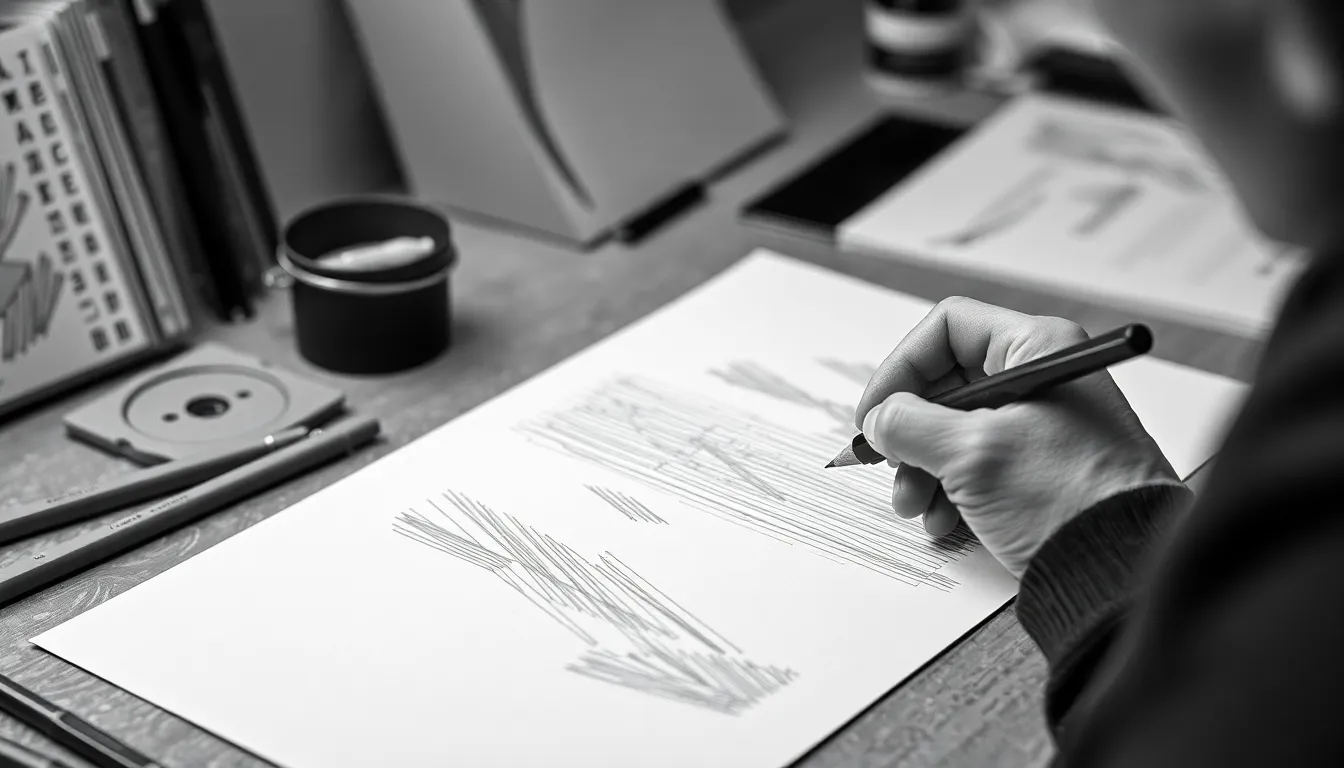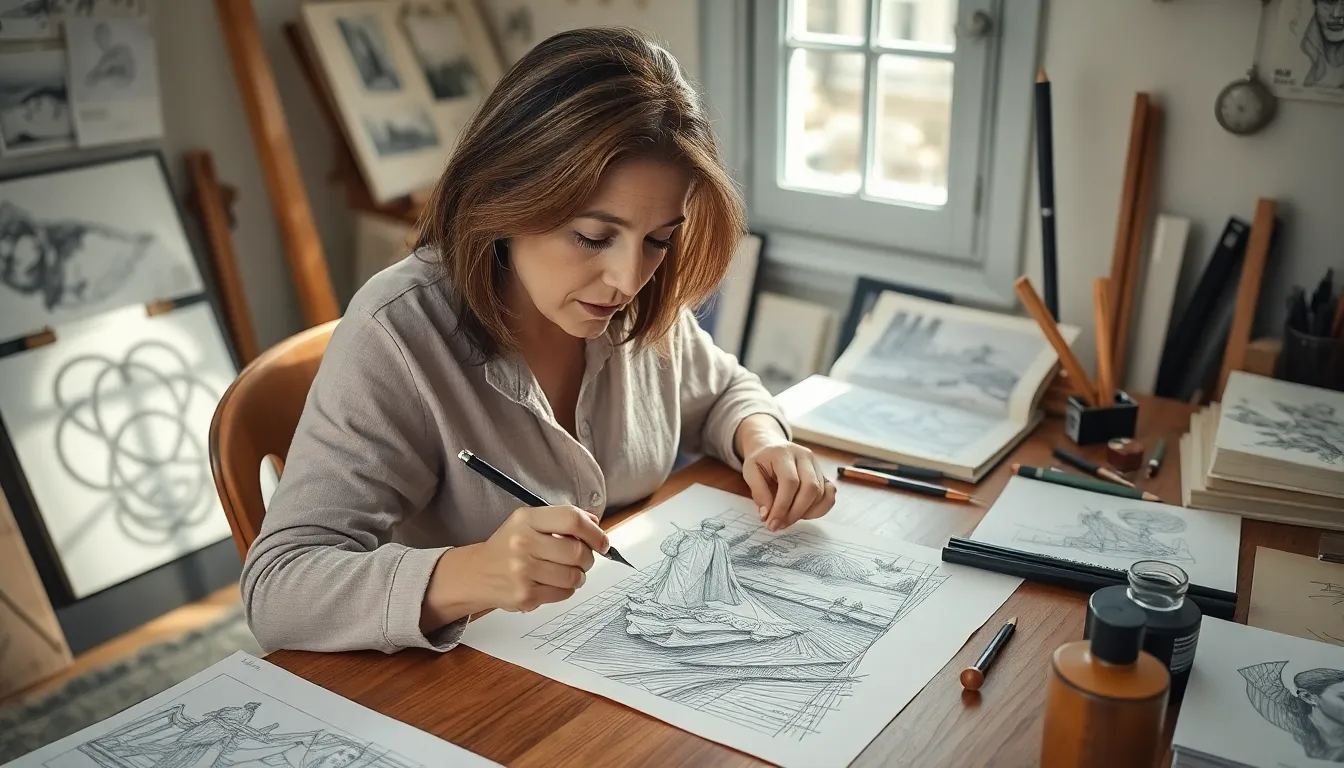Table of Contents
ToggleIn the world of art and design, concept crosshatching stands out like a unicorn at a horse race. This technique transforms flat sketches into dynamic masterpieces, adding depth and texture that can make even the most mundane objects pop off the page. Imagine shading that’s not just a scribble but a well-orchestrated dance of lines, creating visual intrigue that draws the eye and sparks the imagination.
Whether you’re a seasoned artist or a curious novice, mastering concept crosshatching can elevate your work from “meh” to “wow!” It’s not just about filling in spaces; it’s about creating a story with every stroke. So grab your favorite pen and prepare to unleash your inner Picasso—it’s time to dive into the delightful world of crosshatching and discover how to turn your concepts into captivating creations.
Overview of Concept Crosshatching
Concept crosshatching serves as a vital technique in art, enhancing sketches with depth and texture. This method transcends basic shading, producing visual effects that engage the viewer. Artists employ varying line thickness and direction to create complexity within their work.
Different styles of crosshatching exist. Parallel lines establish a simple texture. Crisscross patterns contribute to darker areas and greater dimension. Combining these methods can produce intricate and captivating results. Mastering this technique enables artists to infuse life into otherwise flat representations.
Beginners often find crosshatching an approachable way to develop their skills. This practice encourages experimentation with line work, promoting a deeper understanding of light and shadow. Experienced artists, on the other hand, can push boundaries and refine personal styles by integrating crosshatching.
Art history showcases notable examples that utilize this technique effectively. Renowned artists like Rembrandt and Albrecht Dürer showcased intricate crosshatching in their engravings. Their work emphasizes precision in technique and creativity, inspiring contemporary artists to explore their own interpretations.
Incorporating crosshatching into one’s artistic repertoire elevates storytelling capabilities. Each line drawn communicates emotions and narratives, captivating audiences and inviting engagement. Emphasizing this technique not only enhances visual appeal but also enriches the overall artistic expression.
Techniques Used in Concept Crosshatching

Concept crosshatching employs various techniques that enhance depth and texture in artwork. Artists blend traditional and digital methods to achieve compelling results.
Traditional Methods
Traditional methods of crosshatching involve techniques that date back centuries. Artists often use graphite, ink, or pen for layering lines. Different angles enhance textures, while varied line thicknesses create points of interest. Shading transitions from light to dark can convey volume and depth effectively. Moreover, implementing hatching alongside crosshatching adds complexity to compositions. Artists like Rembrandt mastered these techniques, producing striking contrasts that elevate the viewer’s experience. Understanding these methods equips artists with foundational skills necessary for advancements in their craft.
Digital Approaches
Digital approaches to crosshatching bring a modern twist to classical techniques. Software such as Adobe Illustrator and Procreate allows for precise control over line quality and density. Artists use layers to experiment with different styles, modifying line direction and thickness quickly. Brushes in these programs mimic traditional tools, providing a tactile experience. Additionally, digital tools enable artists to undo mistakes effortlessly, fostering creativity without hesitation. This flexibility attracts both beginners and seasoned professionals, allowing for innovation in their art. Utilizing digital methods opens up new interpretations of crosshatching, broadening its applicability in contemporary art.
Benefits of Concept Crosshatching
Concept crosshatching offers various advantages that enhance artistic expression and communication.
Enhanced Visual Communication
Crosshatching elevates visual storytelling through texture and depth. Artists convey emotions using strategic line placement, engaging viewers in narratives. Each stroke contributes to an overall composition, enriching the message behind the artwork. Distinct line styles produce varying effects, capturing attention in unique ways. Specific techniques, such as layering crisscross patterns, create intense shadow contrasts that evoke drama. This visual language transforms flat sketches into immersive experiences. Audiences appreciate how intricately crosshatching conveys complexity in artistic expression. Artists effectively communicate ideas, guiding the viewer’s eye and fostering emotional connections with their work.
Improved Artistic Skills
Developing proficiency in crosshatching strengthens overall artistic skills. Learning to manipulate line thickness and direction enhances an artist’s control over their medium. Different styles of crosshatching encourage experimentation, promoting creativity and innovation. Artists refine techniques through practice, gaining confidence in their abilities. This ongoing refinement influences their unique artistic voice, allowing for personal style evolution. Mastering crosshatching also cultivates patience and attention to detail, essential traits for any artist. Artists often find that improved skills translate into greater versatility across various mediums. Overall, the practice leads to a richer artistic experience that cultivates lifelong growth and exploration.
Applications of Concept Crosshatching
Concept crosshatching finds diverse applications across various artistic domains, enriching visual storytelling and enhancing creative expression.
In Fine Arts
Fine arts significantly benefit from the application of concept crosshatching. Artists leverage this technique to infuse depth and texture into their works. Masterpieces by figures like Rembrandt often serve as key references. Crosshatching allows artists to create intricate shadows and highlights, bringing figures and landscapes to life. The interplay of lines can evoke emotions and convey complex narratives, appealing to viewers on multiple levels. Additionally, varying line weights accentuate elements within compositions, providing a dynamic viewing experience that captivates audiences. Artists in fine arts embrace this technique as a means of connecting with emotions through visual language.
In Graphic Design
Graphic design employs concept crosshatching to enhance both print and digital mediums. Designers apply this technique to create visual interest and texture within their projects. Posters, illustrations, and branding materials often feature crosshatched elements that draw attention. This method allows designers to establish a unique style, setting their work apart from competitors. Moreover, the versatility of crosshatching provides depth to graphics, contributing to cohesive visual narratives. Using software tools, designers can experiment with line qualities and densities, refining their designs with precision. By integrating crosshatching, graphic designers elevate their work, engaging audiences and reinforcing brand identities.
Concept crosshatching stands as a vital technique in the artistic toolkit. It not only enriches visual narratives but also empowers artists to convey emotions and depth through their work. Whether through traditional or digital methods, mastering this technique opens doors to creativity and innovation. Artists can explore various styles and applications, enhancing their unique voice in the art world. Embracing crosshatching leads to a deeper understanding of texture and form, ultimately elevating the overall artistic experience. By integrating this method, artists can connect more profoundly with their audience, making each piece a compelling story waiting to be told.




